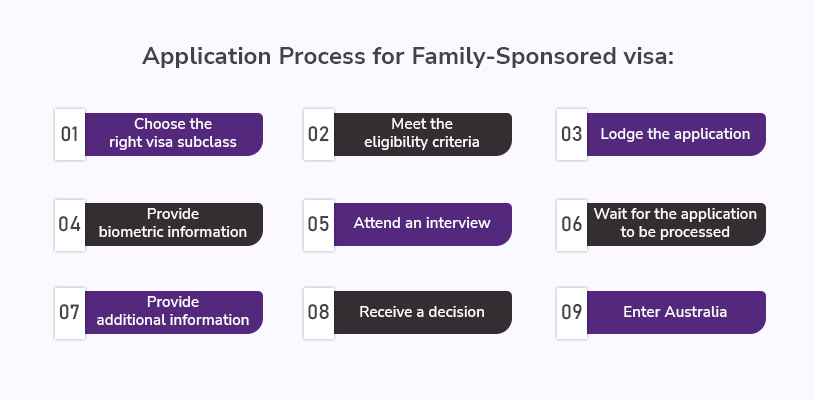Australia is known for its high standard of living, excellent education system, and great job opportunities. It is also one of the most popular destinations for immigrants around the world and there are numerous benefits to studying in Australia. In this blog post, we will explore the family-sponsored visa program in Australia in detail.
Family-sponsored visas are a popular way for people to immigrate to Australia. Moreover, these visas allow eligible family members of Australian citizens or permanent residents to come to Australia and live with their family members.
What is a Family-Sponsored Visa?
A family-sponsored visa is a type of visa that allows eligible family members of Australian citizens or permanent residents to come to Australia and live with their family members. This visa program is designed to reunite families and allow them to live together in Australia.
Family-sponsored visas are a popular way for people to immigrate to Australia, and there are several types of family-sponsored visas available.
To be eligible for a family-sponsored visa in Australia, the applicant must meet specific eligibility criteria, which may vary depending on the type of visa applied for. Furthermore, let’s explore in more detail the different types of family-sponsored visas in Australia:
1. Partner Visa (subclass 820/801)
To be eligible for the partner visa, the applicant must be married to, or in a de facto relationship with, an Australian citizen or permanent resident. The applicant must be able to prove that they have been in a genuine and continuing relationship with their partner for at least 12 months before the visa application is lodged.
Moreover, the applicant must also meet health and character requirements and have enough money to support themselves and any dependents.
2. Parent Visa (subclass 103)
To be eligible for this visa, the applicant must be the parent of an Australian citizen or permanent resident. The applicant must have a child who is settled in Australia and willing to sponsor their parent’s visa application.
Also, the applicant must pass the balance of family test, which means that more of their children live in Australia than in any other country.
3. Child Visa (subclass 101)
To be eligible for this visa, the applicant must be a dependent child of an Australian citizen or permanent resident. The child must be under 18 years of age or a full-time student between the ages of 18 and 25.
4. Contributory Parent Visa (subclass 143)
To be eligible for this visa, the applicant must be the parent of an Australian citizen or permanent resident who is willing to make a significant financial contribution to Australia. Additionally, the applicant must also pass the balance of family test.
5. Remaining Relative Visa (subclass 835)
To be eligible for this visa, the applicant must be a remaining relative of an Australian citizen or permanent resident. Meaning, the applicant must not have any close family members living outside Australia.
Additional requirements
In addition to the above eligibility criteria, all family-sponsored visa applicants must also meet the following requirements:
1. Health requirements
Applicants must undergo a health examination to ensure that they do not have any medical conditions that could be a threat to public health in Australia.
2. Character requirements
Applicants must provide police clearance certificates from all countries where they have lived for 12 months or more in the last 10 years.
3. Financial requirements
Applicants must have enough money to support themselves and any dependents while they are living in Australia. They must also be able to demonstrate that they will not become a burden on the Australian government.
4. Age requirements
Applicants must meet the age requirements for the specific visa type they are applying for. Some visa types have an age limit, while others do not.
Application Process for Family-Sponsored visa

The application process for a family-sponsored visa in Australia can be complex and time-consuming. It requires the applicant to submit various documents and meet specific eligibility criteria. Here are the points to consider when applying for a family-sponsored visa in Australia:
1. Choose the right visa subclass
The first step in the application process is to choose the right visa subclass based on your relationship with the sponsor in Australia. It is essential to choose the right subclass, as each subclass has its own eligibility criteria, the application process, and processing time.
2. Meet the eligibility criteria
Once you have selected the right visa subclass, you need to meet the eligibility criteria for that subclass. You need to provide evidence that you meet the age, relationship, health, character, and financial requirements for the visa subclass.
3. Lodge the application
After you have met the eligibility criteria, you can lodge the visa application. You can do this either online or by post. You need to submit all the required documents and pay the visa application fee.
4. Provide biometric information
As part of the application process, you may need to provide biometric information such as fingerprints, photographs, and signatures. This information helps to confirm your identity and prevent identity fraud.
5. Attend an interview
You may be required to attend an interview with a visa officer to discuss your application and provide additional information.
6. Wait for the application to be processed
After you have submitted your application, you need to wait for it to be processed. The processing time varies depending on the visa subclass and can take anywhere from a few months to several years.
7. Provide additional information
During the application process, you may be asked to provide additional information or documents to support your application. It is important to respond promptly to these requests to avoid any delays in processing your application.
8. Receive a decision
Once your application has been processed, you will receive a decision on your visa application. If your application is approved, you will be issued a visa, and you can travel to Australia to join your family member. If your application is refused, you can seek a review of the decision.
9. Enter Australia
After you have been granted a family-sponsored visa, you can enter Australia and begin your new life with your family. It is essential to abide by the visa conditions and any other requirements of living in Australia.
Challenges faced in the family-sponsored visa application process
The family-sponsored visa application process can be complex and challenging, with many potential obstacles that applicants may face. These challenges can range from meeting the eligibility criteria to navigating the complex visa application system.
In this section, we will discuss some of the challenges that applicants may encounter when applying for a family-sponsored visa in Australia, and how to overcome them.
1. Meeting the eligibility criteria
The eligibility criteria for family-sponsored visas in Australia can be strict and require applicants to provide extensive documentation. Meeting these criteria can be challenging, particularly for applicants who may not have access to certain documents or may have difficulty proving their relationship with the sponsor.
2. Financial requirements
Family-sponsored visa applicants are required to demonstrate that they have enough funds to support themselves while in Australia. This can be difficult for applicants who may not have a stable source of income or savings to meet these requirements.
3. Health and character requirements
Family-sponsored visa applicants are required to undergo a health examination and provide police clearance certificates from all countries they have lived in for 12 months or more. Meeting these requirements can be challenging, particularly for applicants who may have health issues or a criminal record.
4. Language barriers
The visa application process requires applicants to provide documentation and communicate with immigration authorities in English. For applicants who may not be proficient in English, this can be a significant challenge.
5. Visa processing times
Family-sponsored visa applications can take several months or even years to process. This can be difficult for applicants who may be separated from their family members during this time or have other pressing needs.
Overcoming these challenges requires careful planning, attention to detail, and working with a registered migration agent who can guide applicants through the application process. It is important to prepare all required documentation, has a solid understanding of the visa application requirements, and seek professional advice when necessary.
With the right preparation and guidance, applicants can successfully navigate the family-sponsored visa application process and join their family members in Australia.
Conclusion
In conclusion, applying for a family-sponsored visa in Australia requires careful planning and attention to detail. It is essential to choose the right visa subclass, meet the eligibility criteria, provide all the required documents, and respond promptly to any requests for additional information.
Furthermore, the application process can be time-consuming, and it is important to be patient and prepared to wait for the visa to be processed. By following these steps and working with a registered migration agent, you can increase your chances of success and enjoy a smooth transition to life in Australia with your family.
FAQ
What is a family-sponsored visa in Australia?
A family-sponsored visa is a type of visa that allows a person to join their eligible family member who is an Australian citizen, permanent resident, or eligible New Zealand citizen in Australia. This type of visa is available for spouses, children, parents, and other family members of eligible sponsors.
Who can sponsor a family member for a visa in Australia?
An eligible sponsor for a family-sponsored visa in Australia is an Australian citizen, permanent resident, or eligible New Zealand citizen who is 18 years or older and meets the relevant sponsorship requirements for the visa subclass they are sponsoring.
What are the different types of family-sponsored visas available in Australia?
There are several types of family-sponsored visas available in Australia, including partner visas, child visas, parent visas, and other family visas. Each visa subclass has its own eligibility criteria, the application process, and processing time.
What are the eligibility criteria for a family-sponsored visa in Australia?
The eligibility criteria for a family-sponsored visa in Australia vary depending on the visa subclass and relationship with the sponsor. Generally, applicants must meet health and character requirements, provide evidence of their relationship with the sponsor, and meet financial requirements.
Can I work in Australia on a family-sponsored visa?
The ability to work in Australia on a family-sponsored visa depends on the visa subclass and conditions attached to the visa. Some family-sponsored visas allow for work rights, while others do not. It is important to check the specific visa subclass and conditions before applying.





